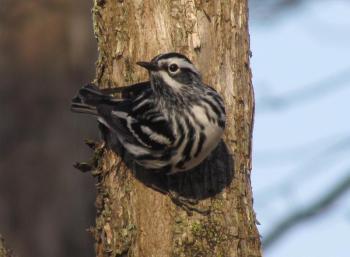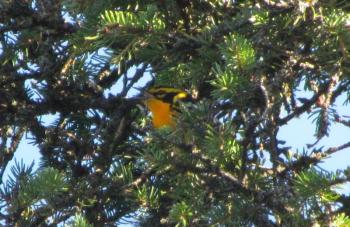Unprecedented Invasion of American Migrants Arrives in Britain and Ireland
 Black-and-white warblers are lovely but expected birds for us to see here in Maine from May through September but when they make their way to the UK, the twitchers there go bonkers. Photo by Jeff Wells
Black-and-white warblers are lovely but expected birds for us to see here in Maine from May through September but when they make their way to the UK, the twitchers there go bonkers. Photo by Jeff Wells
 A blackburnian warbler is gorgeous wherever you get to see it. This one was photographed on its breeding grounds in Manitoba but in September, the remnants of Hurricane Lee brought to Ireland the first one ever recorded there. Photo by Jeff Wells.
A blackburnian warbler is gorgeous wherever you get to see it. This one was photographed on its breeding grounds in Manitoba but in September, the remnants of Hurricane Lee brought to Ireland the first one ever recorded there. Photo by Jeff Wells.
 Northern parula was one of more than a dozen American migrant bird species that were blown off course to Britain and Ireland this fall by Hurricane Lee. Photo by Jeff Wells.
Northern parula was one of more than a dozen American migrant bird species that were blown off course to Britain and Ireland this fall by Hurricane Lee. Photo by Jeff Wells.
 Black-and-white warblers are lovely but expected birds for us to see here in Maine from May through September but when they make their way to the UK, the twitchers there go bonkers. Photo by Jeff Wells
Black-and-white warblers are lovely but expected birds for us to see here in Maine from May through September but when they make their way to the UK, the twitchers there go bonkers. Photo by Jeff Wells
 A blackburnian warbler is gorgeous wherever you get to see it. This one was photographed on its breeding grounds in Manitoba but in September, the remnants of Hurricane Lee brought to Ireland the first one ever recorded there. Photo by Jeff Wells.
A blackburnian warbler is gorgeous wherever you get to see it. This one was photographed on its breeding grounds in Manitoba but in September, the remnants of Hurricane Lee brought to Ireland the first one ever recorded there. Photo by Jeff Wells.
 Northern parula was one of more than a dozen American migrant bird species that were blown off course to Britain and Ireland this fall by Hurricane Lee. Photo by Jeff Wells.
Northern parula was one of more than a dozen American migrant bird species that were blown off course to Britain and Ireland this fall by Hurricane Lee. Photo by Jeff Wells.
In the days before Hurricane Lee made its way toward Maine and Nova Scotia, lots of migrating land birds were moving through our area. We wrote about the TikTok video shared by a Maine lobsterman showing the many birds that were caught offshore before the hurricane’s arrival in the fog and rain, attracted to the lights and landing on boats. Although the birds seen offshore were not there because of the hurricane itself, millions of birds were likely migrating south when Hurricane Lee swept through.
The remnants of Hurricane Lee made it all the way to Ireland and Great Britain, carrying with it some of these same migrating birds who now found themselves in very unfamiliar territory. They had intended to end up in the southern U.S. on their way to the Caribbean, or Central or South America. Instead, the land they sighted was on the other side of the North Atlantic.
Birders in the UK go bonkers when an American bird shows up. If it’s an American warbler that makes an appearance, the birding world there seems to go especially wild. Who can blame them?
Even on this side of the Atlantic, birders love to see a Canada warbler, for example, with its bright yellow breast, white eye-ring, and blue-gray back. This species had never been found in the UK before, and Canada warblers have been on the decline for years, making the odds of one showing up even smaller. So it was a shocked and amazed “twitcher” who discovered Britain’s first-ever Canada warbler at the memorably named St Govan’s Head in Pembrokeshire in mid-September.
The American birds continued to be discovered by those avid British birders. A bay-breasted warbler, the species shown sitting on the head of the lobsterman in the famous TikTok video, was found in the same general region of Britain as the Canada warbler, and was only the second-ever documented for Great Britain. A magnolia warbler, the third record for Britain, was found in the same region followed by another a few days later.
And the American migrants just kept coming: black-and-white warblers, Tennessee warblers, an ovenbird, northern parula, several red-eyed vireos, and Britain’s second-ever Philadelphia vireo. A few Baltimore orioles made it across, too. A striking blackburnian warbler arrived in Ireland, a first there. There were alder flycatchers, cliff swallows, and bobolinks as well. The treasure trove of American migrant birds was the largest ever recorded in Great Britain—something like 16 species and more than 50 individuals in just a week or so!
One of the more fascinating things that we found in researching this news was our discovery of a term apparently unique to British birders: blocker. When a rare bird species occurs in a well-birded geographic area but has not been found there again in many years, that bird is called a “blocker.” Here in Maine, a “blocker” might be a variegated flycatcher, which was found in Biddeford Pool in 1977 and has never been found in the state again. Birders who weren’t born yet would consider that a “blocker” because they are blocked from adding it to their list until another one shows up and they see it, at which time it would become unblocked for them.
Many of these American warblers were “blockers” for many a British twitcher as it had been decades since the last one had been found there.
We hope that birders in Britain and Ireland who’ve had a chance to enjoy some of our American birds over on their home turf will appreciate efforts that many of us participate in to protect and conserve their populations. May there always be enough American migrants that a few can find their way across the Atlantic to serve as beautiful ambassadors from the lands and waters that we cherish.
Jeffrey V. Wells, Ph.D., is a Fellow of the Cornell Lab of Ornithology and Vice President of Boreal Conservation for National Audubon. Dr. Wells is one of the nation's leading bird experts and conservation biologists. He is a coauthor of the seminal “Birds of Maine” book and author of the “Birder’s Conservation Handbook.” His grandfather, the late John Chase, was a columnist for the Boothbay Register for many years. Allison Childs Wells, formerly of the Cornell Lab of Ornithology, is a senior director at the Natural Resources Council of Maine, a nonprofit membership organization working statewide to protect the nature of Maine. Both are widely published natural history writers and are the authors of the popular books, “Maine’s Favorite Birds” (Tilbury House) and “Birds of Aruba, Bonaire, and Curaçao: A Site and Field Guide,” (Cornell University Press).
























